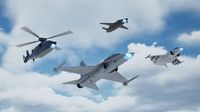In a significant advancement for defense technology, Raytheon has successfully completed the first flight test of its innovative PhantomStrike radar in Ontario, California. This next-generation system, which showcases the ability to track airborne targets and map terrain, represents a leap forward in fire-control radar capabilities.
The PhantomStrike radar is notable for being the first fully air-cooled fire-control radar of its kind, designed specifically to offer long-range threat detection, tracking, and targeting. What sets it apart is its cost-effectiveness; Raytheon claims it provides these advanced capabilities at nearly half the price of typical fire-control radars. This affordability is a crucial factor as military budgets tighten and the demand for advanced technology increases.
According to Bryan Rosselli, president of Advanced Products and Solutions at Raytheon, "The threat environment is evolving, and this test demonstrates how PhantomStrike can make enhanced situational awareness available to a broader set of our partners and allies – offering unparalleled performance and potential U.S. weapons integration – at an affordable price." This statement underscores the strategic importance of the radar system in modern military operations.
Powered by gallium nitride (GaN) technology, the PhantomStrike radar enables aircrew to detect threats at significantly longer distances. Its design is versatile, making it suitable for deployment across various platforms, including uncrewed and light-attack aircraft, fighter jets, helicopters, and ground-based towers. Despite its compact size, it maintains the full fire-control power typically found in larger systems, weighing nearly half that of modern active electronically scanned array (AESA) radars.
The production of the PhantomStrike radar is being carried out in multiple locations, including Forest, Mississippi; Tucson, Arizona; and Scotland, with support from Raytheon UK. This geographically diverse production strategy allows for efficient manufacturing and supports local economies in these regions.
The successful first flight test is a pivotal moment for Raytheon and its PhantomStrike radar, demonstrating not only its technological capabilities but also its potential to reshape the landscape of aerial defense systems. With its advanced features, including a faster and more agile digital beam, enhanced target detection, and strong resistance to jamming, the PhantomStrike radar stands poised to meet the challenges of complex and contested environments.
Raytheon's commitment to innovation in defense technology is evident in the PhantomStrike radar's development. As military operations become increasingly reliant on sophisticated technology, the introduction of such systems is vital for maintaining a strategic edge. The PhantomStrike radar is expected to provide enhanced situational awareness, allowing military forces to respond more effectively to emerging threats.
As defense needs evolve, the introduction of the PhantomStrike radar marks a significant step forward in ensuring that military forces are equipped with the tools necessary for modern warfare. With its combination of affordability and advanced capabilities, the PhantomStrike radar is set to play a crucial role in the future of defense technology.
In conclusion, the successful test flight of the PhantomStrike radar not only highlights Raytheon's technological advancements but also reflects a broader trend in defense innovation aimed at enhancing military readiness and effectiveness in an increasingly complex global landscape.

